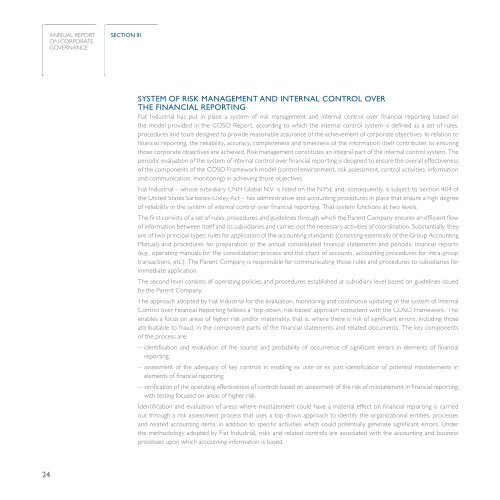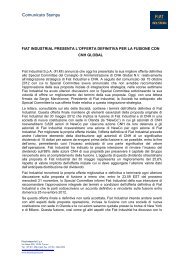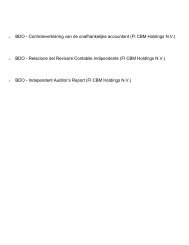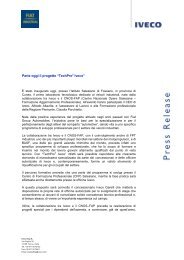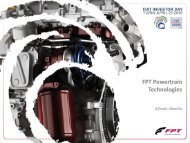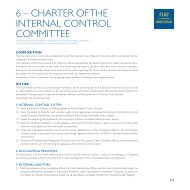Annual Report on Corporate Governance (February ... - FIAT Industrial
Annual Report on Corporate Governance (February ... - FIAT Industrial
Annual Report on Corporate Governance (February ... - FIAT Industrial
You also want an ePaper? Increase the reach of your titles
YUMPU automatically turns print PDFs into web optimized ePapers that Google loves.
24<br />
ANNUAL REPORT<br />
ON CORPORATE<br />
GOVERNANCE<br />
SECTION III<br />
SYSTEM OF RISK MANAGEMENT AND INTERNAL CONTROL OVER<br />
THE FINANCIAL REPORTING<br />
Fiat <strong>Industrial</strong> has put in place a system of risk management and internal c<strong>on</strong>trol over financial reporting based <strong>on</strong><br />
the model provided in the COSO <str<strong>on</strong>g>Report</str<strong>on</strong>g>, according to which the internal c<strong>on</strong>trol system is defined as a set of rules,<br />
procedures and tools designed to provide reas<strong>on</strong>able assurance of the achievement of corporate objectives. In relati<strong>on</strong> to<br />
financial reporting, the reliability, accuracy, completeness and timeliness of the informati<strong>on</strong> itself c<strong>on</strong>tributes to ensuring<br />
those corporate objectives are achieved. Risk management c<strong>on</strong>stitutes an integral part of the internal c<strong>on</strong>trol system. The<br />
periodic evaluati<strong>on</strong> of the system of internal c<strong>on</strong>trol over financial reporting is designed to ensure the overall effectiveness<br />
of the comp<strong>on</strong>ents of the COSO Framework model (c<strong>on</strong>trol envir<strong>on</strong>ment, risk assessment, c<strong>on</strong>trol activities, informati<strong>on</strong><br />
and communicati<strong>on</strong>, m<strong>on</strong>itoring) in achieving those objectives.<br />
Fiat <strong>Industrial</strong> – whose subsidiary CNH Global N.V. is listed <strong>on</strong> the NYSE and, c<strong>on</strong>sequently, is subject to Secti<strong>on</strong> 404 of<br />
the United States Sarbanes-Oxley Act – has administrative and accounting procedures in place that ensure a high degree<br />
of reliability in the system of internal c<strong>on</strong>trol over financial reporting. That system functi<strong>on</strong>s at two levels.<br />
The first c<strong>on</strong>sists of a set of rules, procedures and guidelines through which the Parent Company ensures an efficient flow<br />
of informati<strong>on</strong> between itself and its subsidiaries and carries out the necessary activities of coordinati<strong>on</strong>. Substantially, they<br />
are of two principal types: rules for applicati<strong>on</strong> of the accounting standards (c<strong>on</strong>sisting essentially of the Group Accounting<br />
Manual) and procedures for preparati<strong>on</strong> of the annual c<strong>on</strong>solidated financial statements and periodic financial reports<br />
(e.g., operating manuals for the c<strong>on</strong>solidati<strong>on</strong> process and the chart of accounts, accounting procedures for intra-group<br />
transacti<strong>on</strong>s, etc.). The Parent Company is resp<strong>on</strong>sible for communicating those rules and procedures to subsidiaries for<br />
immediate applicati<strong>on</strong>.<br />
The sec<strong>on</strong>d level c<strong>on</strong>sists of operating policies and procedures established at subsidiary level based <strong>on</strong> guidelines issued<br />
by the Parent Company.<br />
The approach adopted by Fiat <strong>Industrial</strong> for the evaluati<strong>on</strong>, m<strong>on</strong>itoring and c<strong>on</strong>tinuous updating of the system of Internal<br />
C<strong>on</strong>trol over Financial <str<strong>on</strong>g>Report</str<strong>on</strong>g>ing follows a ‘top-down, risk-based’ approach c<strong>on</strong>sistent with the COSO Framework. This<br />
enables a focus <strong>on</strong> areas of higher risk and/or materiality, that is, where there is risk of significant errors, including those<br />
attributable to fraud, in the comp<strong>on</strong>ent parts of the financial statements and related documents. The key comp<strong>on</strong>ents<br />
of the process are:<br />
– identificati<strong>on</strong> and evaluati<strong>on</strong> of the source and probability of occurrence of significant errors in elements of financial<br />
reporting;<br />
– assessment of the adequacy of key c<strong>on</strong>trols in enabling ex ante or ex post identificati<strong>on</strong> of potential misstatements in<br />
elements of financial reporting;<br />
– verificati<strong>on</strong> of the operating effectiveness of c<strong>on</strong>trols based <strong>on</strong> assessment of the risk of misstatement in financial reporting,<br />
with testing focused <strong>on</strong> areas of higher risk.<br />
Identificati<strong>on</strong> and evaluati<strong>on</strong> of areas where misstatement could have a material effect <strong>on</strong> financial reporting is carried<br />
out through a risk assessment process that uses a top-down approach to identify the organizati<strong>on</strong>al entities, processes<br />
and related accounting items, in additi<strong>on</strong> to specific activities which could potentially generate significant errors. Under<br />
the methodology adopted by Fiat <strong>Industrial</strong>, risks and related c<strong>on</strong>trols are associated with the accounting and business<br />
processes up<strong>on</strong> which accounting informati<strong>on</strong> is based.


